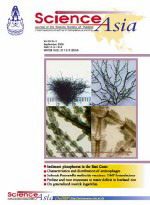ThaiScience
ThaiScience
SCIENCE ASIA
Volume 46, No. 02, Month FEBRUARY, Year 2020, Pages 119 - 127
Co digestion of modified tapioca starch sludge and shrimp pond sediment as a method to improve system stability and biogas production
Piyavadee Srivichai, Orathai Chavalparit
Abstract Download PDF
The objective of this research was to study the anaerobic co-digestion (ACD) process by using two combination types of modified tapioca starch sludge (SS) and shrimp pond sediment (SPS). The response surface method (RSM) was utilized based on the central composite design (CCD) for analysis. Optimum ACD ratios between SS:SPS ratios of 1:0 (pure SS) and 1:1 obtained from the biochemical methane potential (BMP) test were further utilized in a pilot continuous stirred tank reactor (CSTR) test. The CSTR results showed that the highest biogas yield could be achieved at 422 l/kg total volatile solids added (TVSadded) with a methane (CH4) content of 46.66% using a SS:SPS ratio of 1:1. Compared with the digestion of SS alone, the biogas yield was lower at 293 l/kg TVSadded. The completed digestion time of ACD of SS with SPS was 5 days, and a TVS removal of 51.31% was obtained. SPS could help adjust the appropriate ratio of volatile fatty acid to alkalinity (VFA/ALK) along with increasing the system stability. It can be concluded that the ACD system of SS and SPS is capable of converting waste into renewable energy as well as reducing the environmental effects from ineffective disposal management.
Keywords
tapioca starch sludge, shrimp pond sediment, anaerobic co-digestion, biogasSCIENCE ASIA
Published by : The Science Society of Thailand
Contributions welcome at : http://www.scienceasia.org/
